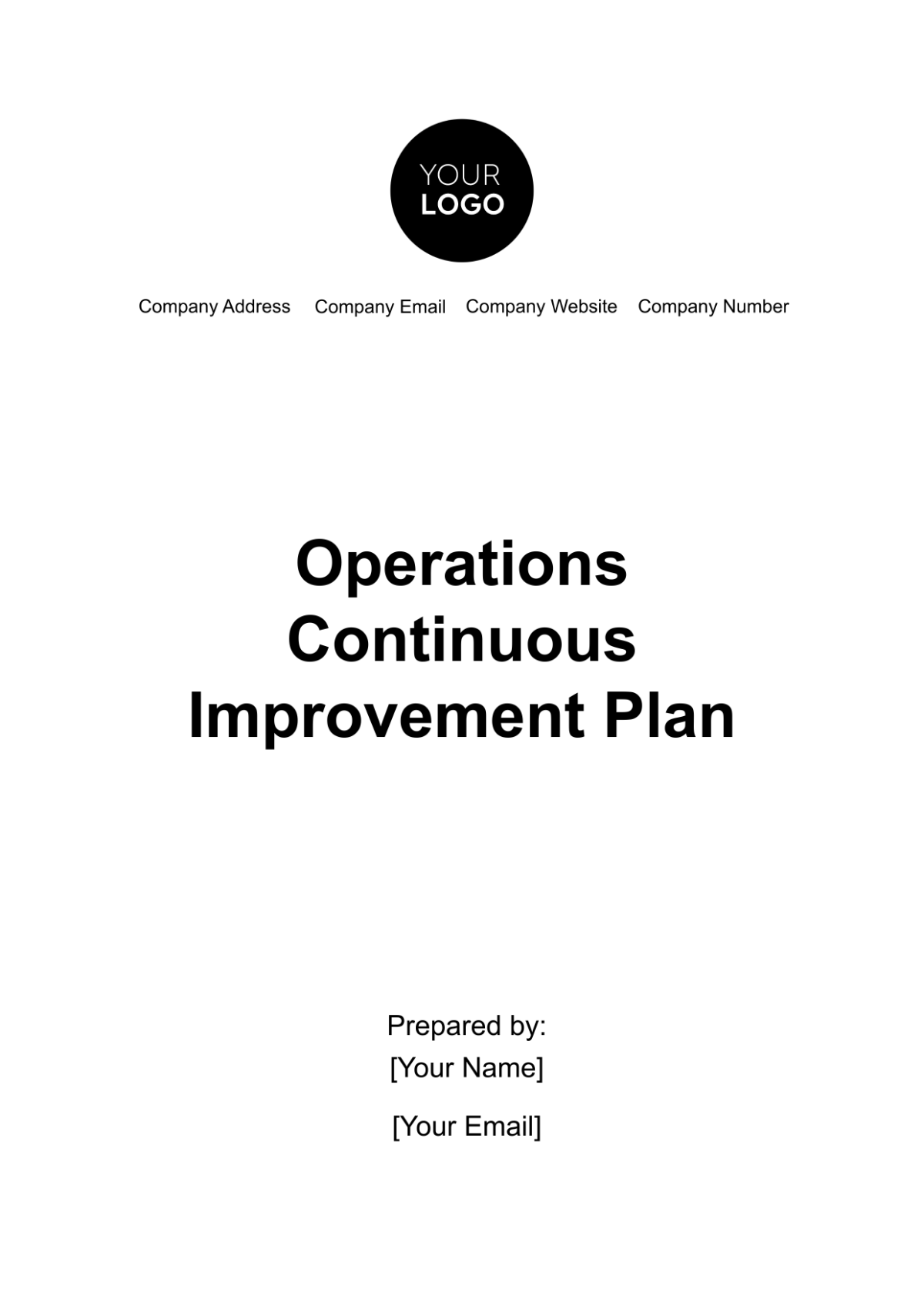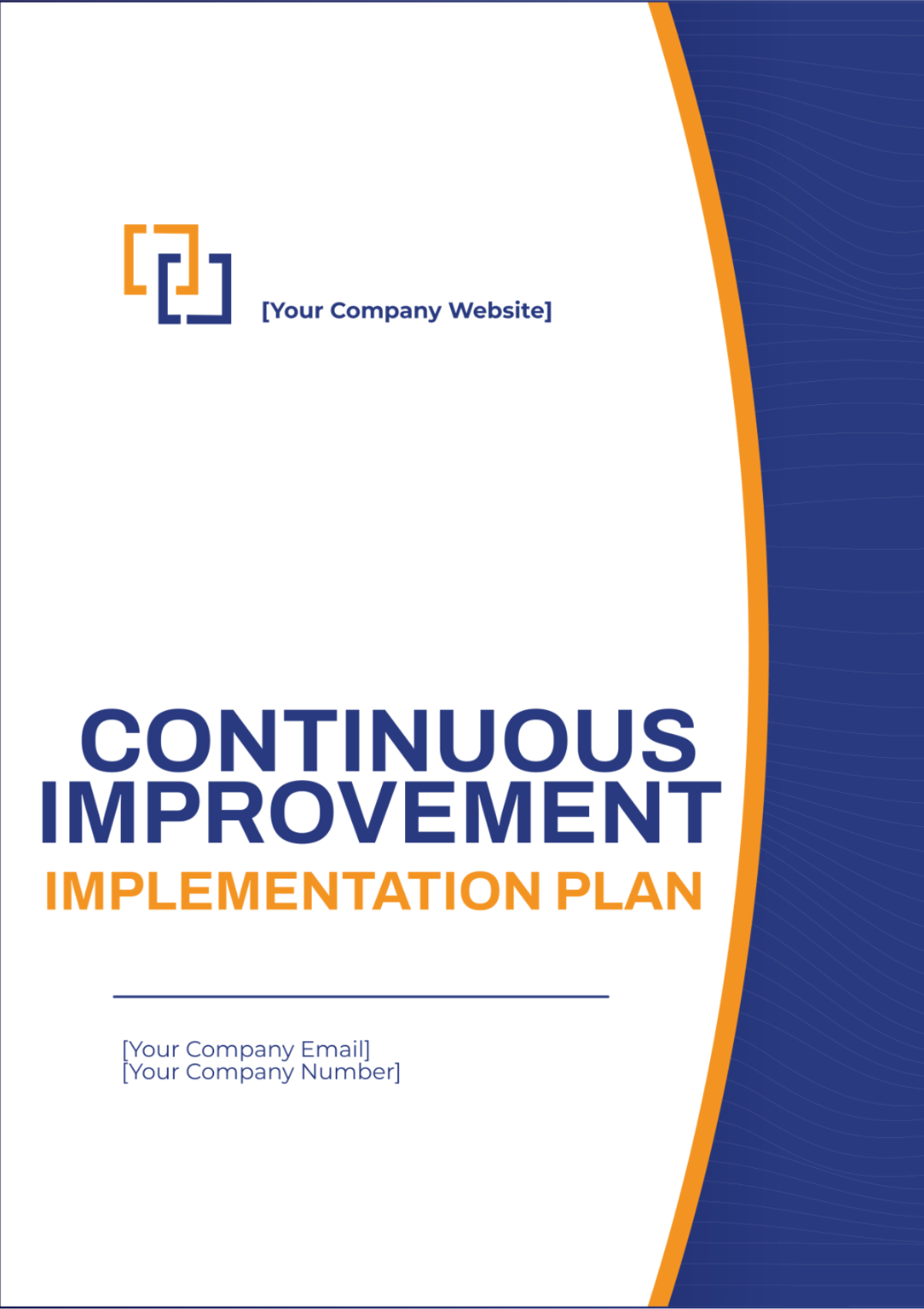Operations Continuous Improvement Plan
I. Executive Summary
Continuous improvement is a critical component of operational excellence. In a dynamic logistics industry, staying ahead of competition and adapting to changing customer demands requires a culture of ongoing enhancement. At [Your Company Name], we are committed to reviewing and refining our processes, workforce skills, and technologies to improve operational efficiency, reduce costs, and meet high standards of service delivery.
II. Process Evaluation and Optimization
Process evaluation is key to recognizing inefficiencies and creating streamlined workflows. By continually auditing and reviewing internal processes, we can reduce waste, enhance delivery timelines, and optimize our supply chain management.
Process Audits To ensure operational efficiency, we will conduct quarterly audits of all key processes, including inventory management, transportation, and warehousing. These audits will be conducted by cross-functional teams to provide a holistic view of how each department functions and interacts. The goal is to identify bottlenecks, eliminate redundancies, and improve turnaround times.
Benchmarking and Best Practices Benchmarking against industry standards and competitors is essential for staying competitive. We will establish key performance indicators (KPIs) that align with best practices in the logistics sector, such as delivery speed, order accuracy, and cost per shipment. Benchmarking will also help us identify areas where we can adopt or refine strategies to ensure consistent improvements.
Implementation of Lean Principles The adoption of Lean methodologies will be key in reducing waste and maximizing value. Lean principles focus on improving flow, reducing unnecessary steps, and increasing the value delivered to customers. Teams will be trained on identifying waste in everyday tasks and empowered to propose and implement solutions to eliminate inefficiencies.
Continuous Feedback Loop Incorporating feedback from employees at all levels ensures that we continuously evolve our processes. Regularly gathering input from frontline workers who handle daily operations will help us quickly identify issues and adapt. A formal feedback mechanism will be established where employees can submit suggestions, which will be reviewed by leadership for potential integration.
III. Employee Training and Development
The success of continuous improvement relies heavily on the skills and expertise of our workforce. By investing in employee training and development, [Your Company Name] ensures that staff remain knowledgeable about the latest operational strategies and technologies, while being capable of adapting to evolving processes.
Ongoing Skill Development Training programs will be designed to provide employees with up-to-date knowledge of industry trends, best practices, and operational tools. These programs will include courses on logistics technology, data analysis, equipment operation, and Lean management techniques.
Leadership Training Management teams will undergo leadership training to better lead continuous improvement initiatives. Training will focus on change management, decision-making, and team motivation, equipping managers to guide their teams through process improvements and align them with the company’s strategic goals.
Employee Involvement in Improvement Initiatives Employees at all levels will be encouraged to take part in continuous improvement initiatives. To foster innovation, we will implement an employee-driven improvement program where individuals can propose new ideas for enhancing operations.
Performance Reviews Linked to Improvement To ensure alignment with continuous improvement, individual and team performance reviews will be updated to reflect contributions to process optimization and efficiency. Employees who actively participate in improvement programs or display measurable gains in efficiency will be rewarded with bonuses, promotions, or additional development opportunities.
IV. Technology and Automation Integration
Adopting advanced technology and automation systems is vital for operational efficiency. Technology will allow us to streamline workflows, reduce manual intervention, and improve data-driven decision-making. This section details the technologies we will adopt, their impact on operations, and how they will enhance our competitive advantage.
Implementation of Advanced Software Solutions We will invest in modern logistics management software that provides real-time tracking, predictive analytics, and automated scheduling. These tools will help optimize route planning, improve inventory management, and allow for more accurate forecasting. Regular upgrades and staff training on new features will ensure we remain ahead of technological advancements.
Automation of Repetitive Tasks Automation will be a key driver in reducing manual workloads and improving efficiency. Tasks such as order processing, inventory updates, and warehouse organization will be automated wherever feasible. Robotics will be considered for repetitive physical tasks, such as sorting or moving goods within warehouses, to reduce labor costs and error rates.
Data-Driven Decision Making By incorporating data analytics into decision-making, we can optimize various facets of the operation. A dedicated team will analyze logistics data to identify trends, predict future demands, and make adjustments to minimize delays and reduce operational costs. Real-time analytics tools will also provide better visibility into fleet management, inventory, and supply chain efficiency.
Cybersecurity Enhancements As our reliance on technology grows, protecting our data and operational systems from cyber threats becomes increasingly important. Regular system audits, updates to security protocols, and employee training on data security will ensure the safety of our digital infrastructure. This will protect the integrity of our operations and client information.
Technology | Estimated Implementation Date | Expected Impact | Cost |
|---|---|---|---|
Advanced Logistics Software | Q1 2051 | Improved delivery accuracy, reduced delays | $50,000 |
Robotic Process Automation | Q2 2051 | Reduced labor costs by 20% | $75,000 |
Machine Learning Forecasting | Q3 2051 | More accurate inventory and supply planning | $100,000 |
Cybersecurity Upgrade | Q1 2051 | Protects customer and operational data | $30,000 |
This table outlines the key technologies that will be integrated into [Your Company Name]'s operations in the upcoming year. Each technology has been selected based on its potential to enhance operational efficiency, lower costs, and improve overall data management. The costs reflect both initial setup and ongoing maintenance to ensure these systems deliver their full potential over time.
V. Maintenance and Equipment Management
Equipment and machinery are at the core of our operations. Ensuring that these assets are well-maintained and function at optimal levels will prevent downtime, reduce repair costs, and support overall operational efficiency. This section focuses on the measures taken to proactively maintain our equipment.
Preventive Maintenance Schedules We will develop and implement preventive maintenance schedules for all key machinery and vehicles. Each piece of equipment will have a detailed maintenance log to track inspections, repairs, and replacements. By adhering to these schedules, we will mitigate the risk of unexpected breakdowns and improve the longevity of our assets.
Condition-Based Monitoring In addition to regular maintenance, we will use condition-based monitoring systems to track the health of critical equipment in real-time. Sensors will alert operators to potential issues before they lead to malfunctions, allowing us to perform targeted maintenance and reduce repair costs.
Training for Equipment Handlers Proper use of equipment is essential for preventing unnecessary wear and tear. All equipment operators will receive training on best practices for handling machinery and will be responsible for performing daily checks before and after use. This will ensure that equipment is operated within its capacity and maintained according to guidelines.
Asset Performance Tracking A system will be put in place to track the performance of all operational assets. Data collected from sensors and maintenance logs will help us evaluate the efficiency and productivity of equipment. This information will inform future decisions on when to repair, upgrade, or replace machinery to optimize cost-efficiency and operational performance.
VI. Customer Satisfaction and Feedback Integration
Customer feedback is critical in guiding continuous improvement efforts. By integrating structured feedback systems, we can enhance service quality, respond to customer needs quickly, and ensure that our operations are aligned with client expectations. This section outlines how customer satisfaction is measured and integrated into our operational improvements.
Customer Feedback Loops We will establish structured feedback loops to gather insights from customers after each service. Clients will be invited to provide feedback on aspects such as delivery timelines, communication, and overall satisfaction. Regular analysis of this feedback will be conducted to identify trends and areas for improvement.
Quality Assurance Initiatives We will develop a quality assurance team to monitor and evaluate service performance, ensuring that we meet or exceed client expectations. This team will also be responsible for implementing changes based on customer feedback, guaranteeing that [Your Company Name] remains responsive to client needs and continuously improves service delivery.
Service Customization and Personalization Based on feedback, we will work toward offering more personalized services to clients. Tailoring our logistics solutions to meet the specific needs of each client will enhance customer loyalty and improve satisfaction rates. Service-level agreements (SLAs) will be customized to provide a more precise match with customer expectations.
Client Retention Strategies To maintain and improve client retention, we will implement strategies focused on building long-term relationships. This includes regularly updating clients on new services or improvements, offering loyalty incentives, and conducting client outreach initiatives to gauge satisfaction and identify potential concerns before they escalate.
Customer Feedback Initiative | Frequency | Expected Improvement |
|---|---|---|
Monthly Feedback Surveys | Monthly | Reduce negative feedback by 15% |
Quality Assurance Team Reviews | Quarterly | Reduce delivery delays by 10% |
Customized SLAs | Ongoing | Improve client retention by 20% |
Client Retention Program | Bi-Annually | Increase repeat business by 25% |
This table outlines key customer feedback and retention initiatives that will be part of the continuous improvement plan. Each initiative has a clearly defined purpose, frequency of implementation, and expected outcome, all of which contribute to improving customer satisfaction and enhancing client relationships.
VII. Conclusion
[Your Company Name] is committed to fostering a culture of continuous improvement in every aspect of its operations. From process optimization to technology integration and customer feedback management, each part of this plan is designed to drive efficiency, enhance service quality, and improve customer satisfaction. By staying responsive to both internal and external insights, the company will continue to grow and maintain its competitive edge in the logistics industry.

